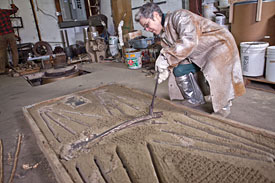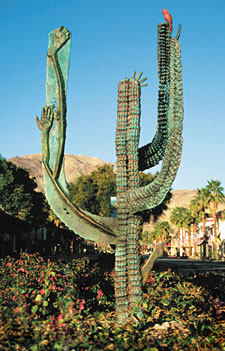Gina Michaels: Creating Airy Collage-like Bronze Sculptures
 Gina Michaels at work in her studio.
Gina Michaels at work in her studio. Photograph courtesy of Gina Michaels
Gina Michaels studied art in Southern France through a Sarah Lawrence College program right out of high school.
"They handed me a hammer and chisel, put me in an abandoned limestone quarry and I spent the next five months carving stone," she recalls. "It was my first experience actually doing nothing but art for weeks."
She went on to acquire her BA in Art and Art History at Oberlin College in Ohio, then moved to New York City where she apprenticed with sculptors Joel Shapiro and Sam Wiener. She lived and worked in New York City for 15 years before relocating to Philadelphia and obtaining a MFA from the University of Pennsylvania. She met and married John Phillips, known for restoring and renovating sculptures. In the late 1990s, they attended a sand-casting party at the studio of Isaac Witkin, a pioneer in the spontaneous use of flowing bronze in sculpture.
"Before the sand-casting party I was a figurative sculptor, creating small bronzes of bodies in movement using the ceramic shell lost-wax process," says Michaels. "On impulse, I pressed my hands and forearms in the sand. We poured bronze into the mold and, when it hardened, turned it over. I was completely blown away by the result. It was archaic and contemporary, figurative and symbolic. My Impressions series, including the large Jacob's Ladder, has its origin in that initial sand pour."
Michaels converted an old 10,000 square-foot sheet metal shop into a studio on Lena Street in Philadelphia, where she is one of a few women in the country fabricating bronze today.
 Hand Plant #11. Bronze sculpture by Gina Michaels
Hand Plant #11. Bronze sculpture by Gina Michaels Photograph courtesy of Gina Michaels
"It all starts in the sandbox," she says. "I use French green sand - a combination of sand, Bentonite clay and water - passed through a griddle for aeration. Hands, arms, legs or body are pressed into the casting sand, recording the speed and arc of movements and creating the pieces in negative. I use a Speedy-Melt crucible furnace that combines city gas with forced hot air to make a really hot flame. Bronze is melted in a crucible to around 2,000 degrees when it is poured (or ladled) directly into the hollows created by the body. My husband designed a funnel specifically for my casting system."
The metal's flow and the "happy accidents" that occur during casting make Michaels' work unique. Sculptural elements are cast flat. "When I need a 3-D curve, I whack the bronze with a heavy mallet until it looks right. Even large hand plants are assembled improvisationally. Rough ideas change before I'm finished. Modern silicon bronze is stronger than traditional bronze and can be welded and juxtaposed for a collage-like effect. Once the welding is complete, hot patina is applied and wax stabilizes the patina and brings out the color and texture."
Michaels has participated in numerous group, public and solo art exhibitions throughout her career. A solo show, "Improvisational Botany: Sculpture and Prints by Gina Michaels," will be held at the Briarbush Nature Center from September 9 to October 30.
Resources:
Also in this Issue:
- On the Road to High Art: Copper Mike's Artisan Motorcycles
- Copper Gardens: Where Gates and the Outside World Join
- Gina Michaels: Creating Airy Collage-like Bronze Sculptures
- Keith Jacobshagen: A Glowing Distillation of Landscape
- The Art of Steampunk by Art Donovan Launched
